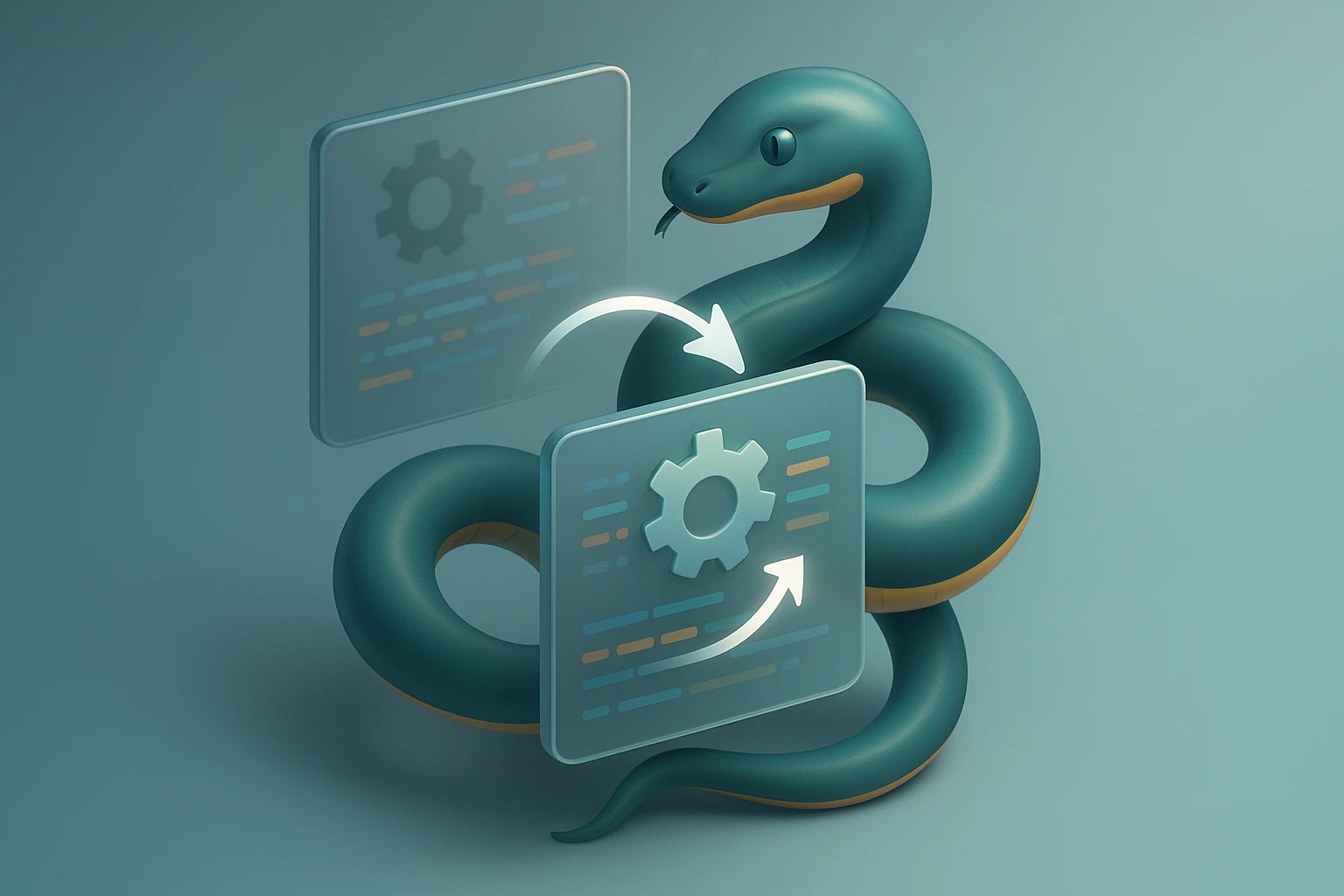What Is the range() Function Used For?
Illustration of Python's range() creating integer sequences from start to stop (exclusive) with optional step, commonly used for loops, indexing, and sequence generation. for loops

Programming often requires us to work with sequences of numbers, whether we're iterating through data, creating patterns, or building complex algorithms. The ability to generate these sequences efficiently and predictably forms the backbone of countless operations in modern software development. Without a reliable mechanism to produce ordered numerical ranges, developers would find themselves writing repetitive code and struggling with basic iteration tasks that should be straightforward.
The range() function is a built-in tool in Python that generates an immutable sequence of numbers, typically used in loops and iterations. This fundamental programming construct offers developers a clean, memory-efficient way to work with numerical sequences without creating unnecessary data structures. Throughout this exploration, we'll examine not just the technical mechanics, but also the practical applications, common pitfalls, and optimization strategies that separate novice implementations from professional-grade code.
You'll discover how to leverage range() for everything from simple counting operations to complex algorithmic implementations. We'll explore its syntax variations, memory efficiency advantages, performance characteristics, and integration with other Python features. Additionally, you'll gain insights into when to use range() versus alternative approaches, how it evolved from Python 2 to Python 3, and practical patterns that experienced developers employ in production environments.
Understanding the Core Mechanics
The range() function operates as a sequence generator rather than creating an actual list of numbers in memory. This distinction becomes crucial when working with large numerical ranges, as it allows programs to maintain minimal memory footprints while still providing access to extensive sequences. When you call range(), Python creates a range object that calculates values on-demand rather than storing them all simultaneously.
This lazy evaluation approach means that whether you're working with a range of 10 numbers or 10 million numbers, the memory consumption remains essentially constant. The range object simply stores the start value, stop value, and step size, then calculates individual values when requested. This design philosophy aligns with Python's emphasis on efficiency and elegant solutions to common programming challenges.
Basic Syntax Patterns
The range() function accepts three parameters that define the sequence characteristics: start, stop, and step. Understanding how these parameters interact provides the foundation for effective usage across diverse programming scenarios.
- Single parameter syntax: range(stop) generates numbers from 0 up to but not including the stop value
- Two parameter syntax: range(start, stop) begins at the start value and continues up to but not including stop
- Three parameter syntax: range(start, stop, step) allows custom increments between values
- Negative stepping: Using negative step values enables countdown sequences and reverse iterations
- Zero-based indexing: Default starting point is 0, aligning with Python's indexing conventions
The most common mistake developers make is forgetting that range() stops before reaching the specified endpoint, leading to off-by-one errors that can be frustratingly difficult to debug in complex applications.
Practical Implementation Examples
Real-world applications demonstrate how range() integrates into everyday programming tasks. Consider iterating through a list to process each element with its index position. Using range() in combination with len() provides a traditional approach that many developers from other languages find familiar and readable.
When building countdown timers, range() with negative steps offers an elegant solution. Starting from a higher number and decrementing to zero creates intuitive logic for time-based operations, game mechanics, or any scenario requiring reverse sequential processing.
Data generation scenarios frequently benefit from range() capabilities. Creating test datasets, populating arrays with sequential identifiers, or generating coordinate systems for mathematical visualizations all leverage range() as a foundational building block. The function's predictability ensures reproducible results across different execution contexts.
Memory Efficiency and Performance Characteristics
The evolution from Python 2's range() to Python 3's implementation represents a significant shift in how the language handles sequence generation. Python 2 actually created a complete list in memory, which could cause performance problems with large ranges. Python 3 transformed range() into an iterator-like object that calculates values on demand, dramatically improving both memory usage and instantiation speed.
| Aspect | Python 2 range() | Python 3 range() | Impact |
|---|---|---|---|
| Memory Usage | Stores complete list | Stores only parameters | Constant vs. linear memory consumption |
| Instantiation Time | Proportional to size | Constant time | Immediate availability regardless of range size |
| Type Returned | List object | Range object | Different methods and behaviors available |
| Iteration Speed | Fast list iteration | Comparable iterator speed | Minimal performance difference in practice |
| Indexing Support | Full list indexing | Calculated index access | Both support indexing, different implementations |
Optimization Strategies
Professional developers recognize situations where range() provides optimal solutions versus scenarios where alternatives prove more efficient. When you need to iterate through indices while maintaining clarity about the iteration count, range() offers explicit readability that enhances code maintainability.
However, when working directly with collection elements rather than indices, Python's iteration protocols provide more Pythonic approaches. Using direct iteration over collections eliminates unnecessary index lookups and reduces cognitive load for developers reading the code later. The enumerate() function bridges these approaches when both elements and indices are needed simultaneously.
Premature optimization often leads developers to avoid range() in favor of more complex alternatives, but modern Python implementations make range() remarkably efficient for its intended use cases.
Advanced Usage Patterns
Beyond basic iteration, range() enables sophisticated programming techniques that experienced developers employ in production systems. List comprehensions combined with range() create powerful one-line data transformations, generating complex sequences with minimal code while maintaining readability.
Slicing operations on range objects demonstrate the versatility of this seemingly simple function. You can extract subsequences, reverse portions, or skip elements using slice notation, all while maintaining the memory efficiency characteristics that make range() valuable for large-scale operations.
Integration with Other Python Features
🔄 The zip() function combined with range() enables parallel iteration across multiple sequences while maintaining index awareness. This pattern appears frequently in data processing pipelines where positional relationships between elements matter.
🎯 Generator expressions leveraging range() create memory-efficient pipelines for data transformation. Unlike list comprehensions that build complete lists in memory, generators produce values on-demand, compounding the efficiency benefits of range() itself.
⚡ Functional programming constructs like map() and filter() accept range objects as inputs, enabling declarative programming styles that emphasize what to compute rather than how to compute it.
🔍 The any() and all() functions combined with range-based iterations provide elegant solutions for existence and universality checks across numerical sequences.
🎨 NumPy and other scientific computing libraries often use range() for generating indices when working with multidimensional arrays, bridging Python's built-in capabilities with specialized numerical computing tools.
Common Pitfalls and Solutions
The exclusive upper bound of range() trips up developers transitioning from other languages or mathematical contexts where ranges typically include both endpoints. When you need a range from 1 to 10 inclusive, you must specify range(1, 11), not range(1, 10). This design choice aligns with Python's zero-based indexing and slice behavior, creating consistency across the language.
Floating-point ranges require alternative approaches since range() only accepts integer parameters. The NumPy library's arange() function or custom generators provide solutions when working with decimal increments. Attempting to use floats with range() raises a TypeError, forcing developers to choose appropriate tools for their specific numerical requirements.
Converting range objects to lists unnecessarily wastes memory and defeats the purpose of using range() in the first place, yet this anti-pattern appears frequently in code written by developers unfamiliar with Python's iteration protocols.
Comparison with Alternative Approaches
Understanding when to use range() versus alternatives enhances code quality and performance. Direct iteration over collections using for loops without range() produces cleaner code when indices aren't needed. This approach reduces cognitive complexity and eliminates potential index-related bugs.
| Scenario | Recommended Approach | Reasoning | Example Use Case |
|---|---|---|---|
| Iterating collection elements | Direct iteration | Clearer intent, fewer potential errors | Processing items in a list |
| Need both index and element | enumerate() | Provides both without manual indexing | Tracking position while processing |
| Fixed number of iterations | range() | Explicit count, clear termination | Repeating an action N times |
| Floating-point sequences | NumPy arange() or linspace() | Handles decimal increments properly | Scientific computing, plotting |
| Infinite sequences | itertools.count() | Unbounded iteration when needed | Event loops, continuous monitoring |
Performance Considerations in Production
Benchmarking reveals that range() performs exceptionally well for its intended purpose, with negligible overhead compared to manual counter management. The function's implementation in C at the interpreter level ensures optimal performance that Python-level alternatives struggle to match.
When dealing with extremely large ranges, even the minimal memory footprint of range objects becomes relevant at scale. In these scenarios, understanding that range() stores only three integers regardless of the sequence length enables confident use in memory-constrained environments.
Micro-optimizations around range() usage rarely provide meaningful performance improvements in real applications, and readability should almost always take precedence over theoretical efficiency gains.
Practical Design Patterns
Experienced developers recognize recurring patterns where range() provides elegant solutions. The "repeat N times" pattern uses range() to execute code blocks a specific number of times without caring about the actual iteration value. This pattern appears in initialization routines, batch processing, and testing scenarios.
Grid generation for two-dimensional operations leverages nested range() calls to create coordinate systems. Game development, image processing, and mathematical simulations frequently employ this pattern to iterate over matrix-like structures efficiently.
Chunking operations that process data in fixed-size batches use range() with custom step values to generate starting indices for each chunk. This approach enables memory-efficient processing of large datasets by loading and processing manageable portions sequentially.
Error Handling and Edge Cases
Empty ranges occur when the start, stop, and step parameters create mathematically impossible sequences. For example, range(5, 1) with a default positive step produces an empty range because you cannot count upward from 5 to 1. Understanding these edge cases prevents confusion when range-based loops don't execute as expected.
Zero step values raise ValueError exceptions since they would create infinite loops with no progression. Python's explicit error handling for this case protects developers from accidentally creating non-terminating iterations that could hang applications.
Negative step values require start values greater than stop values to produce non-empty ranges. This counterintuitive requirement stems from the mathematical logic of counting backward, where you begin at a higher number and progress toward a lower number.
Integration with Modern Python Features
Type hints and static analysis tools understand range objects, enabling better IDE support and early error detection. Annotating functions that accept or return range objects improves code documentation and helps catch type-related bugs before runtime.
Context managers and range() combine in scenarios where resource allocation needs to happen a specific number of times. While less common than other patterns, this combination appears in testing frameworks and resource pooling implementations.
The simplicity of range() belies its power as a fundamental building block that enables complex operations through composition with other Python features rather than through internal complexity.
Testing and Debugging
Unit tests frequently use range() to generate test data and control iteration counts in parameterized tests. The predictability of range() makes it ideal for creating reproducible test scenarios that verify code behavior across multiple input values.
Debugging range-based code benefits from understanding that range objects are lazy. Simply printing a range object shows its parameters rather than the generated sequence. Converting to a list for debugging purposes reveals the actual values, though this should remain a debugging technique rather than production code.
Cross-Language Perspectives
Developers coming from other programming languages find Python's range() both familiar and subtly different. JavaScript's array methods and C's for-loop syntax serve similar purposes but with different semantics and performance characteristics. Understanding these differences helps multilingual developers avoid translation errors when moving between languages.
Functional programming languages often provide range-like functions with different names and behaviors. Haskell's range syntax and Scala's Range class offer more extensive features but require understanding their respective type systems and evaluation models.
Future Developments and Best Practices
Python's evolution continues to refine built-in functions like range(), though its core behavior remains stable to maintain backward compatibility. Future Python versions may introduce performance optimizations or additional methods on range objects, but the fundamental API stays consistent.
Best practices emphasize using range() when iteration count matters more than collection elements. Combining range() with other built-in functions creates readable, efficient code that communicates intent clearly. Avoiding unnecessary conversions to lists preserves the memory efficiency that makes range() valuable.
Documentation should explain why range() was chosen over alternatives when the choice isn't obvious. This helps future maintainers understand the reasoning behind implementation decisions and prevents well-intentioned but misguided refactoring.
Real-World Applications
Web development frameworks use range() for pagination logic, generating page numbers and calculating offset values for database queries. The function's reliability ensures consistent behavior across different request contexts and user interactions.
Data science workflows leverage range() for creating sample indices, splitting datasets, and generating synthetic data for model training. The integration with NumPy and pandas makes range() a bridge between Python's built-in capabilities and specialized data analysis tools.
Game development employs range() for game loop iterations, sprite positioning, and procedural content generation. The function's performance characteristics make it suitable for real-time applications where efficiency matters.
Automation scripts use range() to control retry logic, schedule periodic tasks, and manage batch operations. The clarity of range-based loops makes maintenance easier for operations teams managing production systems.
How does range() differ from creating a list manually?
Range objects calculate values on-demand rather than storing them in memory, making them dramatically more memory-efficient for large sequences. A range of one million numbers uses the same memory as a range of ten numbers, while a list would consume gigabytes of RAM. This efficiency comes with comparable iteration speed, making range() superior for most use cases.
Can range() work with floating-point numbers?
No, range() only accepts integer arguments and raises a TypeError if you provide floats. For floating-point sequences, use NumPy's arange() or linspace() functions, or create custom generator functions that handle decimal increments appropriately. This limitation stems from floating-point arithmetic's inherent imprecision, which could cause unpredictable sequence lengths.
Why doesn't range() include the stop value?
Python's exclusive upper bound design creates consistency with slice notation and zero-based indexing. This convention means range(len(collection)) produces valid indices for every element without off-by-one errors. While initially counterintuitive for some developers, this design choice reduces bugs and aligns with mathematical conventions for half-open intervals.
How do I iterate backward using range()?
Use a negative step value with a start value greater than the stop value, such as range(10, 0, -1) to count from 10 down to 1. The stop value remains exclusive, so range(10, 0, -1) generates 10, 9, 8, down to 1 but not 0. For reversing existing sequences, the reversed() function often provides clearer intent.
Is there a performance difference between range() and manual counters?
Range() typically performs as well as or better than manual counter management due to its optimized C implementation. The difference rarely matters in practice, and range() provides clearer intent and fewer opportunities for bugs. Focus on readability and correctness rather than micro-optimizing between these approaches unless profiling reveals actual performance bottlenecks.
Can I modify a range object after creating it?
No, range objects are immutable. Once created, their start, stop, and step values cannot change. If you need a modified sequence, create a new range object with different parameters. This immutability ensures thread safety and allows Python to optimize range object handling without worrying about concurrent modifications.
How does range() handle very large numbers?
Range() efficiently handles arbitrarily large integers limited only by available memory for storing the three parameter values. Python's arbitrary-precision integers mean you can create ranges with astronomical bounds without overflow errors. However, iterating through such ranges still takes time proportional to the number of elements, so practical limits exist based on computation time rather than representation.
Sponsor message — This article is made possible by Dargslan.com, a publisher of practical, no-fluff IT & developer workbooks.
Why Dargslan.com?
If you prefer doing over endless theory, Dargslan’s titles are built for you. Every workbook focuses on skills you can apply the same day—server hardening, Linux one-liners, PowerShell for admins, Python automation, cloud basics, and more.




